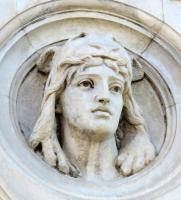
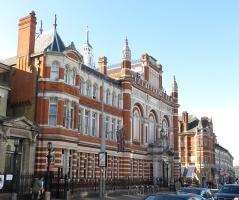

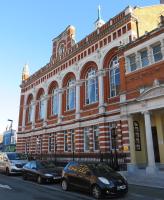
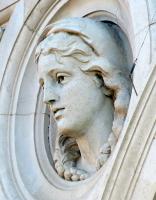
Leyton Town Hall and Technical Institute is a fine Victorian Renaissance style building of interest to these pages for the sculptured heads in above the arches, and a figural panel carved in high relief on the side.
When the Town Hall was built, Leyton was within Essex, with the erection of the building in 1895-96 reflecting part of a reorganisation of local government with the creation of an 'Urban District' which needed a municipal centre. The area, was swallowed up in London’s expansion, and in 1965, along with parts of other counties and all of Middlesex, this whole part of Essex became part of Greater London, with Leyton ending up with Chingford and Walthamstow in the Borough of Waltham Forest.
John Johnson was the architect, and what we see is a fine red-and-white building of Renaissance form, with the main entrance to the right of the frontage onto High Road Leyton, by Adelaide Road. Round the corner in Adelaide Road itself, we see five carved heads above the double-height arched windows on the upper floor: between the pairs of windows are the elegant curved triangular shapes called spandrels (see this page for more spandrel sculpture), and each of these has within it a roundel, within which is the bust of some Classical personage.
John Lawlor's Classical busts on Leyton Town Hall Adelaide Rd facade.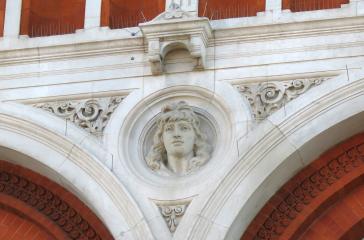
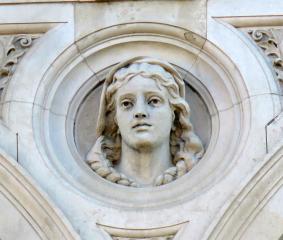
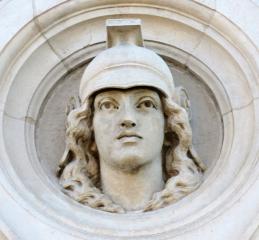
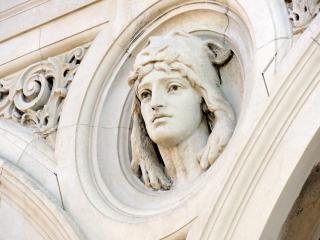
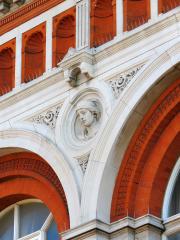
The bust nearest the corner is the most Victorian: while her face is Grecian and her neck powerful, her loose, wavy hair has in a fringe the front and flows down abundantly to her shoulders. The next one along wears some sort of headscarf, pushed back from the brow, under which her tresses of hair form two long plaits making a collar reaching around her throat. The central bust, fittingly, is Athena, the ultimate Goddess and protector of the city, symbolised by her pushed-back helmet, and again with long, flowing hair. Number four is rather androgynous wears a lion skin, so perhaps a young, beardless Heracles, but it is difficult to tell as there is a femininity to the mouth belied by the thickness of the neck. And the last one, again could be male or female, with shorter hair, a headband, and less softness to the chin, more to the cheeks. Regardless of the sex, all are beautifully carved, above all the corner girl and the Athena, with the limpid eyes and sensuous hair being particularly well conceived. John Lawlor, the Irish-born sculptor was the artist: although his best-known work is a enormous Engineering group for the Albert Memorial, he main output was portrait busts, so these ideal heads nicely fit within his oeuvre.
Attached to the rear of the Town Hall along Adelaide Road is the Technical Institute, with nice pillared entrance towards the Town Hall, and a few paces further, the main entrance with an arched porch, a carved gable above with stylised floral carving, and above, a stone panel with figure carving. We see a line of craftsmen, five in all, with a central seated figure in a long coat drawing some design, and to the rear, four standing figures, rather smaller for reasons of perspective (the seated central figure is almost as tall as the standing figures to the sides). They form two pairs: to the left, one man holds some piece of metal to the forge under an arch while the other readies his great mallet; to the right, in front of a similar arch, one man wearing a smock rests, leaning an arm on the rear of the central desk, perhaps, while the other holds some small object near to what might be a rotating file (click to enlarge picture).
F.W. Woodington's sculpture of craftsmen, Leyton Technical Institute.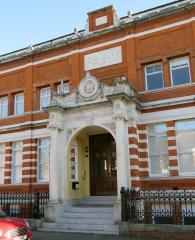
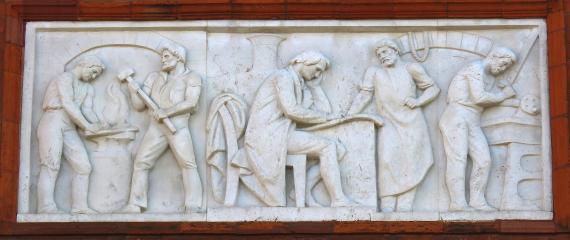
The figures are simply designed, the composition quite elegant: there is a balance and symmetry between the two sides, with their arches and pairs of men, the line of similarly high heads and shoulders, the swirling oval lines made by the workers’ arms and the tops of the arches, but variety is given through the poses, and the two figures on the left facing inwards towards each other, while those on the right face away from each other. The sculptor was W.F. Woodington, who was likely a relative of the better-known William Frederick Woodington ARA, a notable figure who has a number of public statues to his name, including the Queen Victoria in Croydon and numerous pediment sculptures for Birmingham Council House.
To briefly note the main Town Hall frontage onto High Road Leyton, the entrance, with fluted pillars and lots of stone encrustations above,, projects in front of an essentially two storey block, the upper storey being double height with tall arched blind windows; above is a narrow 3rd storey gable (the roof behind can be seen from an oblique view), flanked by pinnacles. To the left of all this, we have a more restrained three storey wing, six narrow bays wide, and then a projecting end with a bay window, small upper curved gable, and mansard roof on top; that side is marked by a wilfully tall chimney. The ground floor is striped with red and white stone, there are brick garlands above the second floor, and a bad of stone decoration above the upper curved windows.
Close by, northwards along High Road, following leftwards as it becomes Grange Park Road, St Mary’s Parish Church, Leyton is to the left along Church Road, and contains a good crop of monuments including some sculpture: see this page.
High Road Leyton, details of building.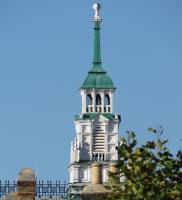
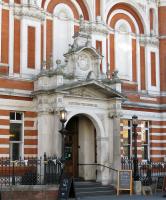
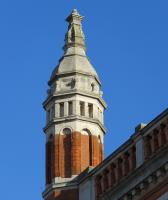
Leyton Parish Church nearby // Walthamstow Parish Church to North // South to Romford Rd and // Passmore Edwards building
Hornchurch Parish Church to the East
Architects and architectural sculpture // London sculpture // Sculptors
Visits to this page from 19 Nov 2017: 4,605